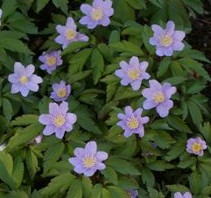 Also known as windflower, this anemone is an herbaceous perennial native to northern and central Europe where it grows in deciduous woodlands. It is a member of the buttercup family, Ranunculaceae, that also includes delphinium, clematis, and hellebore. The plants spread by creeping rhizomes and can carpet the floor before the trees leaf out. The three-part dark green leaves are produced in late winter to early spring and die in the summer. The flowers have six to seven petal-like tepals that can be white tinged with pink or lavender, and yellow stamens surrounding green stigmas. Each flower is about “¾” to “1 ½ “ wide and is produced singly on a short stem just above the foliage in spring. Plants go dormant in summer when the temperatures rise which is signaled by the yellowing of the foliage. Many good cultivars are available that vary primarily in color but also in number and size of petals. Good for naturalizing. The genus name, Anemone, is probably a corrupted Greek loan word of Semitic origin referring to the lament for the slain Adonis or Naaman, whose scattered blood produced the blood-red Anemone coronaria. The specific epithet, nemorosa, is the Latin word meaning well-wooded, and refers to the natural habitat of the plant.
Also known as windflower, this anemone is an herbaceous perennial native to northern and central Europe where it grows in deciduous woodlands. It is a member of the buttercup family, Ranunculaceae, that also includes delphinium, clematis, and hellebore. The plants spread by creeping rhizomes and can carpet the floor before the trees leaf out. The three-part dark green leaves are produced in late winter to early spring and die in the summer. The flowers have six to seven petal-like tepals that can be white tinged with pink or lavender, and yellow stamens surrounding green stigmas. Each flower is about “¾” to “1 ½ “ wide and is produced singly on a short stem just above the foliage in spring. Plants go dormant in summer when the temperatures rise which is signaled by the yellowing of the foliage. Many good cultivars are available that vary primarily in color but also in number and size of petals. Good for naturalizing. The genus name, Anemone, is probably a corrupted Greek loan word of Semitic origin referring to the lament for the slain Adonis or Naaman, whose scattered blood produced the blood-red Anemone coronaria. The specific epithet, nemorosa, is the Latin word meaning well-wooded, and refers to the natural habitat of the plant.
Type: Herbaceous perennial
Bloom: Single, white, pink, lavender, or blue flowers about “¾” to “1 ½ “ in spring on short stalks.
Size: 6” H 12” W
Light: Sun to partial shade
Soil: Rich, organic, medium moist, well-drained
Hardiness: Zones 4-8
Care: Keep weed free and top dress in autumn will well rotted compost
Pests and Diseases: None of significance
Propagation: Seed, division in late summer or autumn
Companion plants: Narcissus
Outstanding Selections:
‘Alba Plena’
-
- – (double white)
‘Robinsoniana’
-
- (large, wisteria blue flowers)
Royal Blue’
-
- (deepest blue)
‘Bowel’ Purple
- (purple flowers)
